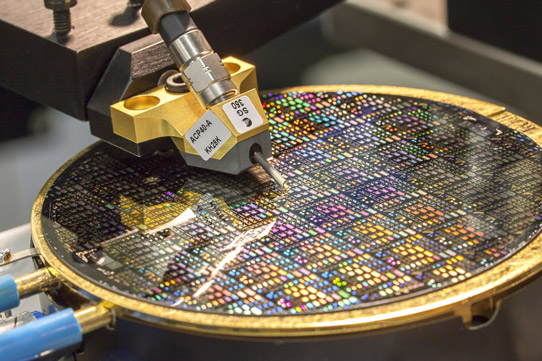- News
22 January 2019
Freiburg-based Power Electronics 2020+ project to grow lattice-matched ScAlN on GaN for transistors with very high voltages and current-carrying capacity
As the demand for increasingly compact and efficient power electronic systems grows and as incumbent electronic components based on silicon will in the foreseeable future no longer be able to meet the increasing industrial requirements, the university of Freiburg, the Sustainability Center Freiburg and the Fraunhofer-Gesellschaft have joined forces to explore a new material structure that may be better suited for future power electronics.
The recently launched project ‘Research of Functional Semiconductor Structures for Energy Efficient Power Electronics’ (‘Power Electronics 2020+’) is researching the novel semiconductor material scandium aluminum nitride (ScAlN). Professor Oliver Ambacher, director of Fraunhofer Institute for Applied Solid State Physics (IAF) in Freiburg, Germany and professor of power electronics at the Department of Sustainable Systems Engineering (INATECH) of the university of Freiburg, is coordinating the supra-regional collaboration.
Three key factors are responsible for the strong growth of the electronics market: the automation and digitalization of the industry, the increasing awareness of ecological responsibility, and sustainable processes. Power consumption can only be reduced if electronic systems become more energy- and resource-efficient while they simultaneously become more powerful.
Silicon technology reaches physical limit
With its relative low cost and an almost perfect crystal structure, silicon dominates the electronics industry, especially because its bandgap allows for both a good charge carrier concentration and velocity as well as a good dielectric strength. However, silicon electronics are gradually reaches their physical limit. Especially with regard to the required power density and compactness, silicon power electronic components are insufficient.
Innovative material composition for more power and efficiency
The limitations of silicon technology have already been overcome by the use of gallium nitride (GaN) for power electronics. Compared with silicon, GaN performs better for high voltages, high temperatures and fast switching frequencies. This is accompanied by much higher energy efficiency — with numerous energy-consuming applications, this means a significant reduction in energy consumption. Fraunhofer IAF has been researching GaN for electronic components and systems for many years. With the help of industrial partners, the results of this research work has already been put to commercial use. The project Power Electronics 2020+ will go further in order to once more enhance the energy efficiency and durability of the next generation of electronic systems. For this purpose, a different and novel material will be used: scandium aluminum nitride (ScAlN).

Picture: Characterization of ScAlN-based high-frequency filters on a wafer. © Fraunhofer IAF
First components based on ScAlN
ScAlN is a piezoelectric semiconductor material with a high dielectric strength which is largely unexplored worldwide with regard to its usability in microelectronic applications. “The fact that scandium aluminum nitride is especially well suited for power electronic components, due to its physical properties, has already been proven,” notes Dr Michael Mikulla, project manager for Fraunhofer IAF. The aim of the project is to grow lattice-matched ScAlN on a GaN layer and to use the resulting heterostructures to process transistors with high current-carrying capacity. “Functional semiconductor structures based on materials with a large bandgap - such as scandium aluminum nitride and gallium nitride - allow for transistors with very high voltages and currents,” says professor Oliver Ambacher, director of Fraunhofer IAF. “These devices reach a higher power density per chip surface as well as higher switching speeds and higher operating temperatures. This is synonymous with lower switching losses, higher energy efficiency and more compact systems,” he adds. “By combining both materials, GaN and ScAlN, we want to double the maximal possible output power of our devices while at the same time significantly lowering the energy demand,” says Mikulla.
Pioneering work in materials research
One of the biggest challenges of the project is crystal growth, considering that there are so far neither growth recipes nor empirical values for this material. The project team needs to develop these during the coming months in order to reach reproducible results and to produce layer structures that can successfully be used for power electronic applications.
Specialist collaboration and knowledge transfer between Freiburg and Erlangen
The research project will be conducted in close cooperation between the university of Freiburg, Fraunhofer IAF, the Sustainability Center Freiburg as well as the Fraunhofer Institure for Integrated Systems and Device Technology (IISB) in Erlangen, which is a member of the High-Performance Center for Electronic Systems in Erlangen. This new form of collaboration between university research and application-oriented development will serve as a role model for future project cooperation.
“On the one hand, this model facilitates the cooperation with companies through the prompt transfer of results from basic research to application-oriented development. On the other hand, it opens up synergies between two technically complementary Fraunhofer Centers from two different regions and thus improves both their offers for potential customers of the semiconductor industry,” says Ambacher.


